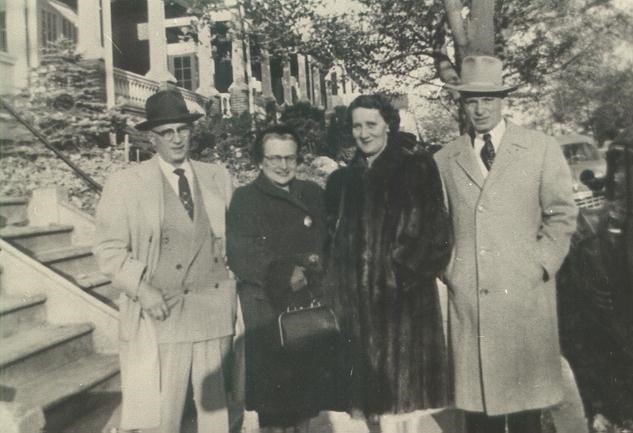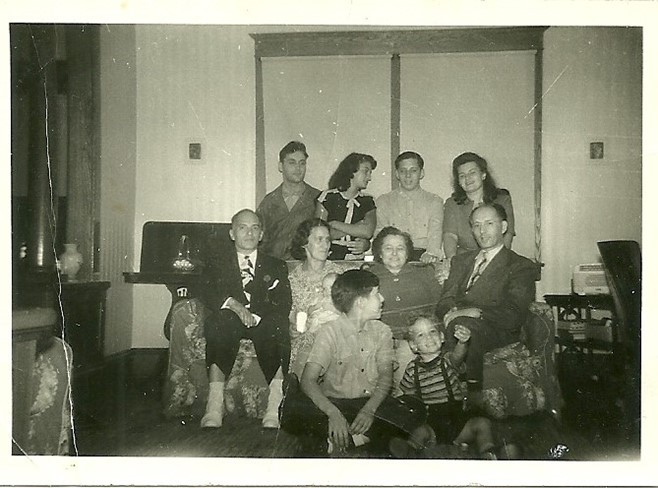Fred Schock’s parents, Harry and Celia (Morris) Schock, were married in Bronx, NY on February 22, 1925. Marriage license recorded on Jan. 9, 1925.
BACKGROUND

1908 Morris Family Photograph
- Samuel Morris (1876 Brest-Litowsk, Russia – Nov 18, 1943 Brooklyn, NY)
- Mamie [Rappaport] Morris (Sept 1877 Grodna, [Belarus] Russia – Nov 27, 1967 New Rochelle, NY )
- Celia Schock (July 4, 1901 Brest-Litovsk – July 4, 1901 – Dec. 3, 1989 Baltimore MD)
- Martha (October 2, 1908 Easton, PA – June 2005 New York City),
- Donald (Oct. 7, 1910 Easton, PA – April 2005 Coney Island, NY),
- Jacob (March 1, 1914 – July 14, 1937) [not shown in picture.]

Celia Schock , Samuel’s daughter, came to the United States with her mother in 1903; her father had emigrated to the US earlier.

Harry Schock (Girsh Shokhor) was the son of Peisakh and Sheva Freide Shokhor. (see from Shokhor to Schock). He was born in 1897 in Kovno (now Kaunas), Lithuania.

Harry’s given name Girsh (see Historical Documents, original and translation), Hershel in Yiddish, would eventually become Harry in English. The aforementioned Russian document, issued by the Kovensky Military Authority on February 28, 1914, reveals his full name: Girsh Peisakhovich Shokhor.
Searching The LitvakSIG All Lithuania Database Web site of historical records re Shokhors reveals the following:

In the second column above are the first names of Harry Schock’s paternal father and grandfather as well as the first names of his mother and maternal grandfather. His and brother Isaac’s father’s name, Peisakh, would be used for both Harry’s and Isaac’s first born: Paul Schock and Paul Schocker. His mother’s name (Freida) would be used to name Harry’s second born, yours truly, Fred Schock.
Note: while Harry Schock celebrated his birthday on October 8 and all Official US documents list his birth year as 1897, his birth date as shown above is October 21, 1897.
The following is a list of other closely related Shokhors with birth dates and immediate family information.

Gilel, Khana and Sora Shokhor in the above chart have the same Father, Grandfather, Mother and Grandfather as that given for Girsh Shokhor (Harry Schock). In addition, another section of the chart shows that Yakov Shokhor, Chaya Sore, Yakov Reuven and Chaya Etil have the same relatives. The above chart and the following reveal that there were 7 related Shokhor births.

The following chart shows Yakov Ruvin Shokhor listed as “Head of Household” who “Resides in Kaunas, section No. 3-7, his mother is widow”. The Rugia ship’s Manifest states that Yakov Shokhor, of Kovna, is “. . . nearest relative or friend in country from whence alien came”. He, no doubt, is Girsh’s, Iizik’s and Khaya’s brother then serving the “Head of Household for the orphaned family.


In the second row, Aizik (Isaac) Shokhor is listed as brother to Girsh (Harry) Shokhor. The “Age This Revision” blocks show that Aizek is 8 and Girsh is 5. Given that Aizik was born in 1894 and Girsh in 1897, this confirms that these are the brothers Harry Schock and Isaac Shokhor. Their sister, Khaya Etlya Shokhor’s middle name might very well been the stimulus for the naming of Isaac’s youngest daughter Elke (Ella | Eke – pronounced Eck-key)
Harry’s father (Pesach) died in Russia when he was two and his mother (Freda) died leaving him an orphan at the age of ten. The following chart shows that Harry and Isaac’s mother Freyda died of apoplexy is 1909.

To better understand the steps followed in the search for the original documentation, see the graphs and text below.
Clicking on the highlighted microfilm number (1186822) in the far right-hand column in the above chart took me to

Here’s the fourth image in the top row enlarged:

I then looked for series no. 7:

And in this series, Record # F (female) 83 (column 1)

Here’s the chart again showing the death information for Sheva Freida Shokhor in 1909.

The LitvakSig database entries of Shohkor births in Kaunas, Lithuania from 1881 to 1897 appear below. Note that Iizik Shokhor, who was born in 1894, is not included in the list.



Isaac and Harry emigrated to the United States with Isaac coming first (c. 1911) and a few years later Harry (1914).

Harry and Isaac (Ike) July 1, 1951 Easton, PA

Shortly after WWII my father received a letter from a “Rosenberg” living in Johannesburg, South Africa, requesting financial assistance. Harry and Isaac’s sister, whose married name could have been Rosenberg, might have emigrated to Johannesburg, SA. Not being sure of the request’s validity, my father ignored the request. Harry Schock and Isaac Schocker (uncle Ike) are the only family members known to have emigrated to the United States.

Schocks and Schockers circa mid-1940s
Front row: Fred Schock and Alan Jacobs (Jeanette’s son)
Sitting on sofa: Isaac and Bella Schocker; Celia and Harry Schock
Standing: Paul Schocker, Eke (Elke) Schocker, Paul Schock and Jeanette Schocker Jacobs
FROM SHOKHOR TO SCHOCK
Harry Schock’s brother, Isaac, came to the US three years before my father. Isaac’s 1917-1918 Draft Registration Form shows his surname as Schocker. (Shokhor eventually became Schockor and then Schocker.) As of December 2018, I have not been able to find his Petition for Naturalization or his Certificate of Naturalization. Harry came in 1914 from Kaunas (Kovno), Russia (Lithuania) and became a U.S. citizen in 1922 changing his last name on his Certification of Naturalization from Schochor to Schock. His Russian passport might have enabled him to begin his journey from Kovno, Lithuania to Hamburg, Germany where he boarded a ship that would take him to the United States.
It wasn’t until November 2018 that I discovered a vital link that helped solve several mysteries about my father Harry’s voyage to the United States. Although he told me when I was a teenager that he boarded a ship in Hamburg, Germany, it wasn’t until I was able to find a copy of his 1917-1918 US Draft Registration Form (USDRF) on Ancestry.com that I learned the spelling (Schochor) he used for his last name before changing it to Schock. I also found a Philadelphia, Pennsylvania, Passenger List Card showing the Schochor spelling and also indicating that his brother Itsik (Isaac) Schocker provided the ticket. For years I had searched records using Schockor, Schocker and Schock but never SCHOHOR.
[An explanation of the “Usage of KH in transliteration from Cyrillic, Hebrew and others” clarified the change from Shokhor to Schochor. Further google research reveals the similarities that exist between Sh and Sch.]
With the correct spelling in hand, I checked the Hamburg Passenger Lists for 1914 and discovered that Harry Schochor boarded the S. S. Rugia 2 in Hamburg on April 29, 1914 just three months before the onset of World War I, July 28, 1914. With a stop in Emden, Germany. the S.S. Rugia 2 crossed the Atlantic arriving in Philadelphia, PA on May 15, 1914. Line 12 of the S. S. Rugia’s manifest confirms Harry Schochor’s presence aboard and shows that he listed (his oldest brother) Yakov Schochor (Kovno), [line 12, far right column] as “the nearest relative or friend in country from whence alien came.”
FROM LITHUANIA TO THE UNITED STATES
So how did Harry Schock as well as Isaac, Bella and Paul Schocker leave Lithuania and make their way to the United States? One might also ask, how come their son Paul Schocker’s birthplace – on multiple documents – is given as Kibart, LT even though the family was from Kovno (Kaunas)? And why did my father have a Russian passport? As for my aunt, uncle and cousin, the answer might be found in the fact that Kibart is on the border with Germany as described in an article about Kibart in which the author also describes the “Smuggling of Emigrants.” Putting these few pieces of the puzzle together conjures up the thought that the Schockers went to Kibart so that they would be near the German border; After Paul was born, they made their way across the border into Germany and eventually to Hamburg which was on the rail line from St. Petersburg to Hamburg via Kibart. The destination in Hamburg had to be the Hamburg-American Line.
Official documents reveal that my father made his way from Hamburg, Germany to the United States via the S.S. Rugia. No official, personal documentation or word of mouth, however, has provided information to show how he made the journey from Kaunas, Lithuania to Hamburg, Germany. It’s not without merit to think that he followed in his brother’s family’s footsteps. The fact that he had a Russian Passport to travel within “Jewish Communities” might have also enabled him to cross the border at Kibart. Another part of the puzzle is the indication on his U.S. arrival card that he was born in Suwalki, Russia where, at the beginning of the 20th Century a Russian railway line had been completed.



The following excerpt from Tomas Balkalis’s “Opening Gates to the West: Lithuanian and Jewish Migrations from the Lithuanian Provinces, 1867–1914, p. 58, describes the various routes taken: (my highlights)
“Within Lithuania, the migrants took the four major routes that let them near and across the Russian–German border. The northern route, Libava – Kretinga – Bajorai – Tilsit, attracted those who departed mainly from Kovno, Courland and Livland provinces. The second route went along the Ri- 59 Opening Gates to the West: Lithuanian and Jewish Migrations from the Lithuanian Provinces, 1867–1914 ver Nemunas from Kovno through Jurbarkas to Bajorai. Meanwhile, two southern routes started in Alytus and Grodno and converged in the German town, Eydtkuhnen, from where all migrants traveled to Tilsit. These routes were taken largely by migrants from Vilna, Grodno, Minsk and Vitebsk provinces. . . . Since emigration from Russia was unlawful and a receipt of a foreign Russian passport was heavily bureaucratic, expensive and could take up to a half year, the vast majority of emigrants preferred to cross the border illegally. The crossing was made relatively easy by a large network of emigration agents and local peasants living from human and goods’ trafficking. . . . Within Lithuania, the hotbed of migrant recruitment became the city of Vilna where dozens of agents operated. Other major cities where they worked were Kovno, Minsk, Libava, Odessa and Yekaterinoslav (Эйдинтас, 1989: 53). Yet the network of agents sprawled all over Lithuania including towns of Sventzani (Švenčionys), Jashune (Jašiūnai), Olitta (Alytus), Širvintos, Vilkomir (Ukmergė) and many others. In fact, according to one official observer, almost every town in Lithuania had one or two secret Jewish emigration agents (Офросимов, 1912: 10–11). The agent network was significant for both Jews and Lithuanians looking for an exit.”
Historical Note: The Pale of Settlement
Harry Schock Time Line (overview)
Harry Schock died in Lindenwold, NJ on November 8, 1978 and Celia Schock died in Baltimore, MD on Dec. 3, 1989. Both are interred in Har Yehuda Cemetary, Upper Darby, PA